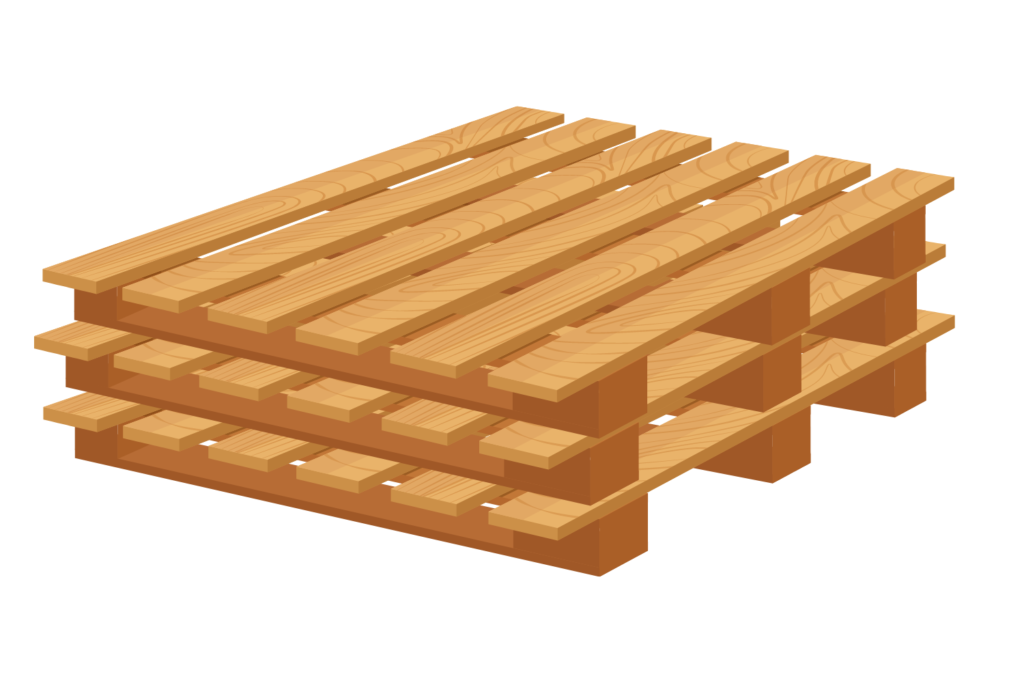Euro Pallet
Euro Pallet Definition
The euro pallet is a wooden loading unit which is manufactured, exchanged and traded under precise regulations of the European Pallet Association (EPAL) and has the dimensions 120 cm x 80 cm x 14.4 cm. It has a base area of 0.96 m² and is a four-way pallet, which means that it can be picked up from all four sides by ground conveying equipment (e.g. forklifts or pallet trucks). The average load capacity of a it is 1,500 kg. The euro pallet, also referred to as an EPAL pallet/EUR pallet, is taken from a pool of pallets and exchanged. The euro pallet was born out of the need for a standardised way to transport goods without repacking them or taking up unnecessary space.
Properties of a euro pallet
A euro pallet is manufactured under strict quality guidelines and must fulfil a number of criteria. It weighs approx. 20–30 kg (depending on moisture and age) and consists of a total of exactly nine blocks, eleven boards and 78 nails. Additionally, the types of wood used are strictly defined–euro pallets may only be made from the wood of pine, fir, spruce, larch, acacia, maple, aspen, birch, beech, sweet chestnut, oak, alder, ash, hemlock, poplar, sycamore or elm. An original euro pallet is always marked with the oval-shaped EPAL branding on the left and right.
A look back: Origin and history of the euro pallet
In 1961, members of the International Union of Railways (UIC) signed a contract for a standardised transport platform for Europe. The aim was to ensure that no more valuable stowage space was wasted in freight transport. The contracting parties were responsible for the manufacturing and repair of the euro pallet. In 1991, the European Pallet Association (EPAL) was founded to both organise and control the pool of euro pallets. EPAL ensures the consistent quality of the euro pallets and grants licences to producers and repairers of the pallets.
What makes the euro pallet so special?
Due to their standardised dimensions, euro pallets are very well suited for truck transport, because exactly two pallets crosswise or three pallets lengthwise fit into the loading space of a tractor-trailer or a swap body of approx. 2.40 m. The dimensions of containers and high racks are also based on the euro pallet dimensions. Although American pallet dimensions apply to sea freight, there are also special inland containers that are aligned to the dimensions of the euro pallet.
Pallet exchange
EPAL pallets are usually used as reusable pallets. In contrast to non-exchangeable one-way pallets, euro pallets are of a uniform, higher quality and have a higher durability. However, pallet exchange is not common in all EU countries.
In the exchange system, you deliver a loaded pallet and receive an unloaded pallet in return. In the exchange, the euro pallet must again meet the quality criteria and be considered new, as good as new or used. Damaged euro pallets are no longer exchangeable and may only be repaired by EPAL licensed companies. The advantage of this exchange pool is that both sender and receiver save the costs of buying new pallets or having unnecessarily many pallets in stock.
New euro pallets are considered as such if they are actually new and come directly from the manufacturer.
Euro pallets that have been exchanged no more than twice before are considered as good as new.
Used euro pallets have already been exchanged more than twice.
Exchange criteria:
- Manufacturing by an EPAL licensed company according to EPAL criteria.
- EPAL/EUR marking on the blocks must be present
- All boards are present and undamaged; no nail shanks visible
- All blocks are present; a maximum of one nail shaft is visible
- The general condition is good (not rotten or dirty)
However, the exchange of pallets is not mandatory, depending on the agreement of the business partners. Another option is for the receiver to purchase the euro pallets. This is then stipulated in the order placement and freight documents and the euro pallets taken over are receipted and settled on the freight documents. Alternatively, the logistics industry usually works with so-called pallet accounts. In this case, the euro pallets delivered and received over a defined period are allocated to an account and settled at the end of the period.
Quality differences
Due to the wear and tear during loading and unloading, a wear rate is often estimated at the time of exchange. Unfortunately, attempts are made to counterfeit euro pallets, which is why attention should be paid to the above-mentioned criteria and the brands.
